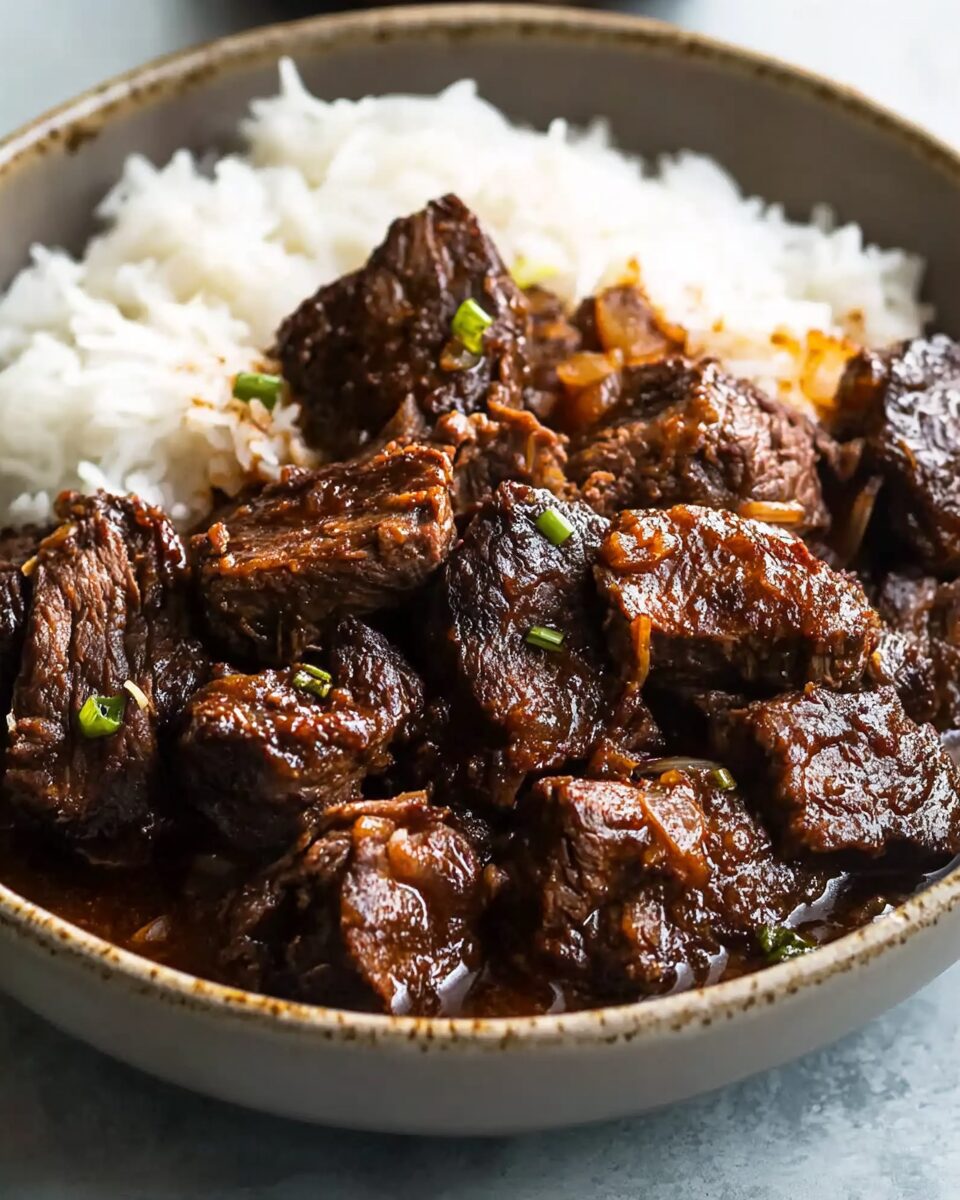This easy Filipino beef adobo is a comforting dish perfect for cooler weather. Made with beef short ribs braised in a savory blend of soy sauce, vinegar, garlic, and spices, it delivers the classic Filipino adobo flavor that’s both tangy and rich.
FULL RECIPE:
Ingredients:
- 3 pounds bone-in beef short ribs
- Kosher salt and freshly ground black pepper, to season
- 2 tablespoons neutral cooking oil (e.g., vegetable oil)
- ¼ cup garlic, minced
- 1 yellow onion, halved and sliced into ⅛-inch thick slices
- ½ cup soy sauce
- ¼ cup brown sugar
- 3 large bay leaves
- 1 teaspoon whole black peppercorns
- ½ cup cane vinegar (e.g., Datu Puti)
- 1 cup water
Directions:
- Prepare the Short Ribs: Remove the short ribs from the refrigerator 30 minutes before cooking. Pat them dry with a paper towel to remove excess moisture. Season all sides with kosher salt and freshly ground black pepper.
- Sear the Meat: In a 3.5-quart braiser or heavy-bottomed pot, heat the neutral cooking oil over medium-high heat. Add the short ribs and brown them on all sides, about 10-15 minutes. Once browned, remove the short ribs and set them aside on a plate.
- Sauté Aromatics: In the same pot, with about 2½ tablespoons of oil remaining, add the minced garlic and sliced onion. Sauté over medium heat until fragrant and softened, approximately 4 minutes.
- Add Seasonings: Incorporate the soy sauce, brown sugar, bay leaves, and whole black peppercorns into the pot. Stir the mixture until all ingredients are well combined.
- Introduce Vinegar: Pour the cane vinegar into the pot but do not stir. Cover the pot with a lid and allow the contents to reach a boil before stirring.
- Braise the Beef: Once the mixture is boiling, return the browned short ribs to the pot and add the water. Bring the contents back to a boil, then turn off the heat. Cover the pot with the lid and transfer it to a preheated oven set at 325°F (163°C). Let it cook for 2 to 2½ hours, flipping the short ribs once halfway through, until the meat is tender and easily pulls apart.
- Finalize and Serve: After braising, skim off any excess oil from the surface and discard any loose bones. Serve the beef adobo hot over steamed Jasmine rice.
Nutrition Facts
- Calories: 510 kcal
- Total Fat: 27 g
- Saturated Fat: varies
- Cholesterol: varies
- Sodium: approximately 2,190 mg
- Total Carbohydrates: varies
- Dietary Fiber: varies
- Sugars: varies
- Protein: approximately 37 g
- Vitamins and Minerals:
- Iron: varies
- Potassium: varies
Origins and Cultural Significance of Filipino Beef Adobo
Filipino Beef Adobo is a variation of the traditional adobo dish, which is widely recognized as one of the most iconic and beloved Filipino recipes. The term “adobo” originates from the Spanish word meaning “to marinate,” but the dish itself predates Spanish colonization. Early Filipinos used vinegar and salt to preserve meat, as refrigeration was not available at the time. When the Spanish arrived, they observed this preservation technique and named it adobo, though the cooking process itself was entirely indigenous. Over the years, adobo evolved with the introduction of new ingredients. Chinese traders brought soy sauce to the Philippines, which became a common substitute for salt, adding a more complex umami depth to the dish. While chicken and pork adobo are the most common, beef adobo has gained popularity for its rich, hearty flavor and tender texture when slow-cooked.
The Unique Appeal of Filipino Beef Adobo
Filipino Beef Adobo stands out from other variations due to its deep, umami-rich sauce. Unlike chicken or pork, which quickly absorb the flavors of the marinade, beef requires a longer cooking time to break down the connective tissues and become tender. This slow braising process ensures that the beef short ribs fully absorb the complex flavors of soy sauce, vinegar, garlic, and spices, creating a dish with layers of depth. Another distinguishing factor is the balance of flavors. Traditional Filipino adobo is known for its signature tanginess from vinegar, which acts as a natural tenderizer while enhancing the dish’s overall taste. The addition of soy sauce provides saltiness and umami, while garlic and black peppercorns contribute a fragrant, slightly spicy undertone. Some versions of beef adobo also incorporate brown sugar, which adds a subtle sweetness that balances the acidity of the vinegar.
Why Slow Cooking is Essential for the Best Beef Adobo
One of the most important aspects of cooking beef adobo is the slow braising process. Since beef is a tougher protein compared to chicken or pork, it requires a longer cooking time to become tender and absorb all the flavors. Braising the beef at a low temperature over an extended period allows the connective tissues to break down, resulting in meat that is fork-tender and infused with the rich flavors of the sauce. The slow cooking process also allows the sauce to develop a thicker consistency. As the beef simmers in the mixture of soy sauce, vinegar, and spices, the liquid reduces, intensifying the flavors and creating a silky, flavorful sauce that clings to the meat. Some variations of beef adobo include an oven-braised method, where the beef is cooked in a covered pot in the oven rather than on the stovetop. This method ensures even cooking and helps retain moisture, preventing the meat from drying out.
Pairing Beef Adobo with the Perfect Sides
Filipino Beef Adobo is best enjoyed with a simple side of steamed white rice. The mild, fluffy texture of rice complements the rich and flavorful sauce, soaking up all the delicious juices from the beef. For those who prefer a heartier meal, garlic fried rice is a fantastic alternative, adding an extra layer of savory flavor to the dish. To balance the richness of the adobo, many Filipinos enjoy serving it with a side of pickled vegetables, such as atchara (pickled green papaya) or pickled cucumbers. The acidity and crunch of the pickles provide a refreshing contrast to the deep, umami flavors of the beef. A simple side salad with fresh tomatoes, onions, and a drizzle of calamansi juice can also brighten up the meal and add a hint of citrusy freshness. For those looking to enhance the dining experience further, beef adobo pairs well with sautéed greens, such as kangkong (water spinach) or bok choy. The light bitterness of the greens complements the savory sauce and provides a nutritional boost to the meal. Some people also enjoy pairing beef adobo with mashed potatoes or buttered vegetables for a fusion-style twist.
Variations of Beef Adobo Across the Philippines
Filipino cuisine is known for its regional diversity, and beef adobo is no exception. In some parts of the Philippines, coconut milk is added to the dish, creating a version known as “Adobo sa Gata.” The addition of coconut milk results in a creamy, slightly sweet variation that balances the acidity of the vinegar. This version is particularly popular in the Bicol region, where coconut-based dishes are a staple. Another variation is “Adobong Pula,” which incorporates annatto oil to give the dish a reddish hue. This type of adobo is often found in the Visayan region, where annatto seeds are commonly used in cooking. Some regions also include potatoes or hard-boiled eggs in their beef adobo, adding extra texture and heartiness to the dish. For those who enjoy a spicier version, chili peppers or crushed red pepper flakes can be added to give the dish a bit of heat. This is a common variation in areas that enjoy bolder, spicier flavors.
Tips for Making the Best Beef Adobo
Achieving the perfect beef adobo requires a few key techniques. First, using high-quality ingredients makes a significant difference. Opting for a good brand of soy sauce and cane vinegar ensures that the dish has a well-balanced and authentic flavor. Filipino brands such as Datu Puti or Silver Swan are commonly used for their distinct taste. Searing the beef before braising is another essential step. Browning the meat creates a rich depth of flavor and enhances the overall taste of the dish. Cooking the garlic until it is fragrant but not burnt is also important, as burnt garlic can add bitterness to the sauce. Allowing the vinegar to cook properly is crucial for balancing the flavors.
Conclusion
Filipino Beef Adobo is more than just a dish; it is a representation of the country’s rich culinary heritage and adaptability. Rooted in traditional preservation methods and influenced by various cultures over time, adobo has evolved into a beloved staple that every Filipino household has its own version of. The beef variation of adobo brings a unique twist to the classic dish, offering a rich, deep flavor that is perfect for slow-cooked comfort food. With its tender meat, flavorful sauce, and cultural significance, beef adobo is a dish that continues to bring families together.






